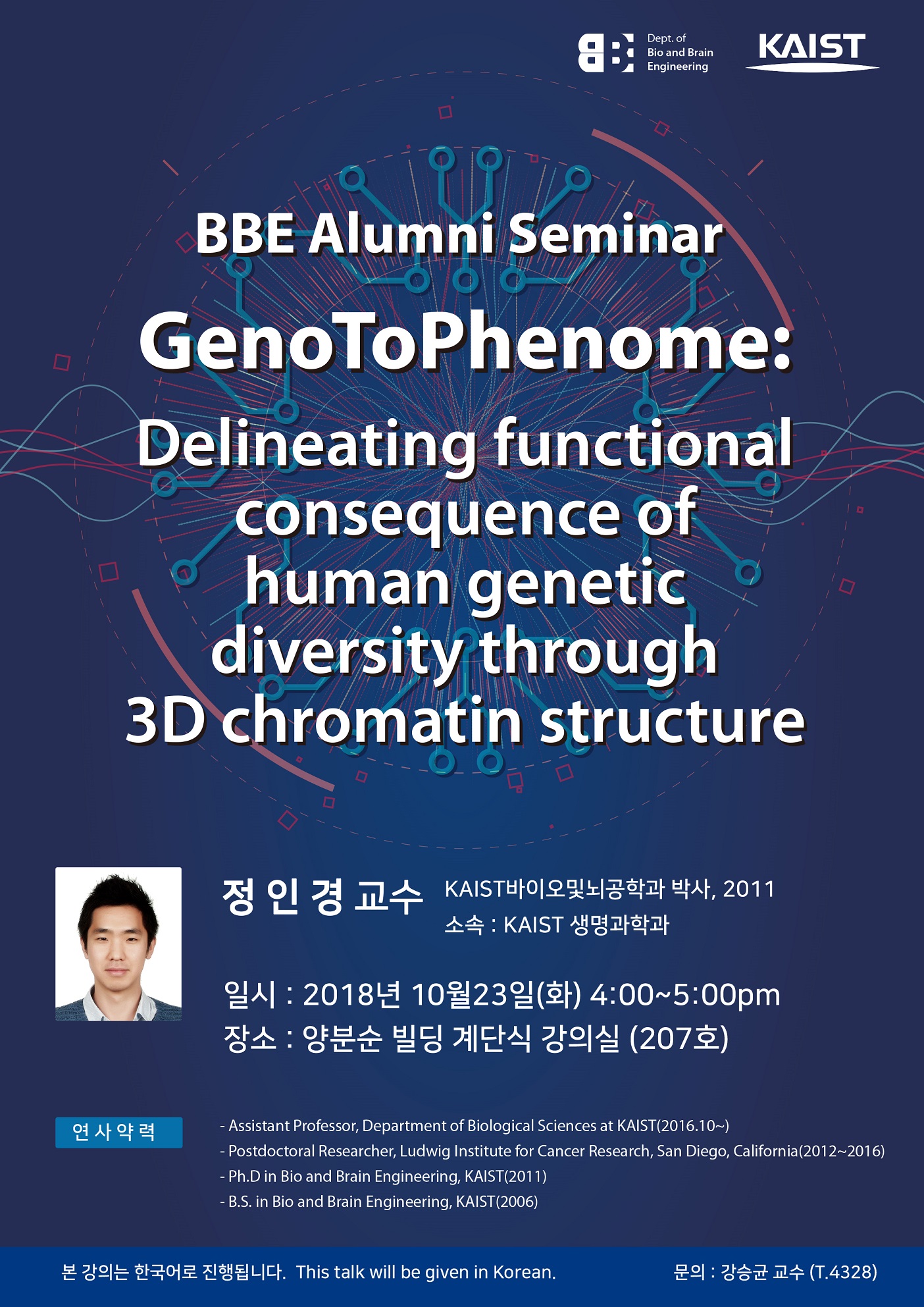| 연사 | 정인경 교수 |
|---|---|
| 소속 | KAIST 생명과학과 |
| 일시 | 2018. 10.23(화) 4PM~5PM |
| 장소 | E16-1 양분순빌딩.#207 |

10월 23일(화)에 KAIST 생명과학과 정인경교수님을 연사로 모시는 BBE Alumni Seminar가 아래와 같이 개최됩니다.
정인경 교수님은 바이오및뇌공학과 학부 및 박사과정을 졸업하신 동문 선배님으로서 재학생 분들과 질의응답 시간 등을 통해 교류할 수 있는 기회가 있으니 학부, 대학원 학생 여러분들의 많은 참여를 부탁드립니다!
* 간단한 다과가 제공됩니다!
-아 래-
1. 제목 : GenoToPhenome: Delineating functional consequence of human genetic diversity through 3D chromatin structure
2. 연사 : 정인경 교수 (KAIST 바이오및뇌공학과 박사, 2011, 소속: KAIST 생명과학과)
3. 일시 : 2018년 10월23일(화) 4:00~5:00pm
4. 장소 : 양분순 빌딩 계단식 강의실 (207호)
5. Abstract:
The age-old question why we differ from one another still intrigues and captivates us, but the reason for our similarities and uniqueness remains a mystery. The collection of traits that each individual specifically expresses makes unique phenotypes that are controlled in large by genotypes. Although vast population genome sequencing projects and genome-wide association studies have been conducted to better understand how human genetic diversity is related to phenotypic traits, the mechanism by which genotypes generate specific phenotypes is not fully understood. Especially, most individual-specific genotypes are located in non-functionally characterized genomic regions (noncoding regions), making it difficult to interpret individual specific phenotypes. To solve this problem, we try to uncover the way in which the genome is packed into a highly-ordered chromatin structure in the nucleus, while keeping its ability to coordinate the expression of hundreds of genes during development and various cellular processes as a mechanism of genetic variants located in noncoding regions. Thanks to the recent advances in high-throughput chromatin conformation capture methods we are able to investigate 3D chromatin structure in which distant DNA fragments can be juxtaposed in space. Using this method, we generate maps of long-range chromatin interactions centered on 18,943 promoters in 27 human cell/tissue types to bridge the gap between a large number of disease-associated genetic variants and the genes they control. We use this information to infer the target genes of 42,633 non-coding sequence variants associated with 2,117 physiological traits. Integrative analysis of these promoter-centered interactome maps reveals novel disease-disease associations and common molecular pathways underlying distinct groups of human traits and diseases. Furthermore, we have applied our approach to multiple complex human diseases including Parkinson’s diseases and colorectal cancer. In this talk, I will discuss the utility of 3D chromatin structure in delineating new mechanisms underlying various human diseases-associated non-coding sequence variants by bridging the gap between individual-specific genotype and phenotype.






